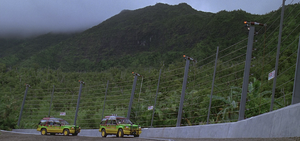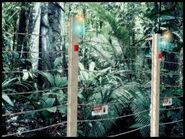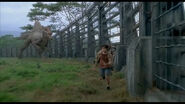
The Tyrannosaur perimeter fence.
The Electric Fences were used to contain the cloned dinosaurs in the park, and some areas of Site B.
On Isla Nublar
The fences were first seen in service on Isla Nublar. They were anywhere between ten to thirty feet tall! They had a minimum of 10,000 volts of electricity to stop the dinosaurs from attempting escape, however, this was a severe problem as well, because it could fry a dinosaur, killing it and making it no use to the public eye unless they liked watching dinosaurs eating cooked meat... It was also their fatal flaw, when Nedry turned off the electric power he made the almighty 10,000 volt fence a bunch of useless wires.
On Isla Sorna
On Isla Sorna there were several broken down electric fences. A perimeter fence that lined the Worker Village and a stretch of specialised fencing near the Aviary observatory. Jurassic Park III 's worker village fencing was the same type as the perimeter fencing on Isla Nublar complete with the same style gating. However the elements had taken their toll on them and by 1997 the wiring and support poles were sagging. Even with the deterioration, the fencing still is capable of running electricity as evident by the lights atop each pole being lit up when Nick Van Owen restores the power to the compund in order to send a distress call. The fencing outside the Pteranodon aviary as seen in Jurassic Park 3 is very heavily built. A row of lthick, albeit hollow barss run parallel to the ground, with the inner side lined with meshed cable wiring. The topmost bar, roughly 30ft or more in the air, is armed with large spikes pointing in all directions. Each section of fencing is connected by large triangular beams. Due to the age of the fence and lack of maintenance, the Spinosaurus crashed through the fence with ease.
Debate
The electric fences required at least 10,000 volts of voltage to contain the dinosaurs properly, this is an assumption, as mention is made about whether or not direct current or alternating current was used. Also, it should be noted that it is in fact current, not voltage, that kills things (at least with the Tyrannosaur). It is assumed the same voltage was used for all the other dinosaur enclosures, although too high a voltage for certain animals, it would most likely kill them depending on their size, and preventing dinosaur deaths was a big concern. The fences were electrified to discourage the dinosaurs from attempting to escape. Certainly it's okay for a Tyrannosaur to take a mild 10,000 volt shock probably along with the Triceratops and Stegosaurus due to their thick hides and size, but that type of voltage would likely kill smaller dinosaurs.
The Dilophosaurs in the park being just infants and only 3ft tall would problably poke their heads through the fences to get a better shot when they spit their venom. The Compys roamed around in 2-3 large groups in different enclosures. If one of the compys were to hit the fence by mistake, it is certainly not likely to survive.
The Tyrannosaurus perimeter fence has one main design flaw. You can see that the larger fence posts have ceramic guide bolt to fix each horizontal wire onto the fence post. However between each of the larger posts are a smaller post which each electric wire makes direct contact with, sending the current straight to earth.
Jurassic Park-inspired games
- The electric fence has appeared in nearly all Jurassic Park games, mostly as scenery or hazards for the player.
- In Jurassic Park: Operation Genesis, electric fences, known in-game as Security Fences, must be built in order to create dinosaur enclosures. There are 3 types of fences, depending on their security level and strength:
- Low Security Fence: These were made for enclosures containing small carnivores (except raptors) and herbivores. These were the weakest and the cheapest.
- Medium Security Fence: These were made for raptor enclosures as well as for some large carnivore/herbivore enclosures.
- High Security Fence: These were made for most large carnivores and herbivores. These were the strongest and therefore, the most expensive.



